Friday Frivolity no. 10: If I Lived on the Moon...
Lunar experiments, explorations, & associations
This is an installment in the section Friday Frivolity. Every Friday, you'll get a little micro-essay, plus a moodboard, 3 things I'm currently in love with, words of wisdom from what I've been reading lately, a shimmer of poetry, a "beauty tip," and a question to spark your thought.
—
If I Lived on the Moon…
Adèle heard him, and asked if she was to go to school “sans mademoiselle?”
“Yes,” he replied, “absolutely sans mademoiselle; for I am to take mademoiselle to the moon, and there I shall seek a cave in one of the white valleys among the volcano-tops, and mademoiselle shall live with me there, and only me.”
—Charlotte Brontë, Jane Eyre1
Unimaginative people (scientists) tell us that the moon is an inhospitable place; it harbors no life. However, seeing as a few of our best and brightest—or, at least, our wealthiest—are contriving to unleash the horrors of human habitation upon that poor planet Mars, and as we may conjecture that these men, given their success in pecuniary matters, are not complete dummies, we may be so bold as to venture a picture of human life on what we find to be a dearer, perhaps more homey sphere—more familiar, more lovely, more endowed with certain mystical associations that lend it an aura of magic, enigma, and allegory—I mean, of course, the moon.
Now, let us put aside everything we know about craters and dust and grey surfaces and a lack of water and a dearth of life. The other day, as I was contemplating this fickle disk, this most changeable orb, I had a notion that I would like to live there in a silvery little valley, where the grass would sparkle with an unearthly light and the dew would hang upon each dove-gray blade like pearls. There the trees would have bark like alabaster—or some would, at least, and others would have bark like moonstone, and still others like mother-of-pearl, with leaves of a silvery iridescence, shimmering when a moon-wind chanced to rustle them. From these various timbers, I would build a little cottage, and there I would be content. A stream would run by it, like a rippling cloth of pale lamé, containing a liquid shining and mercurial—sweeter than water, more limpid and more healthful, though over time it would lend the skin a slight silver shimmer. Of an evening, I would sit by the window, listening to this stream flow by—in my mind it would give out a very gentle tintinnabulation—and look out upon the Earth in the distance or gaze upon the stars.
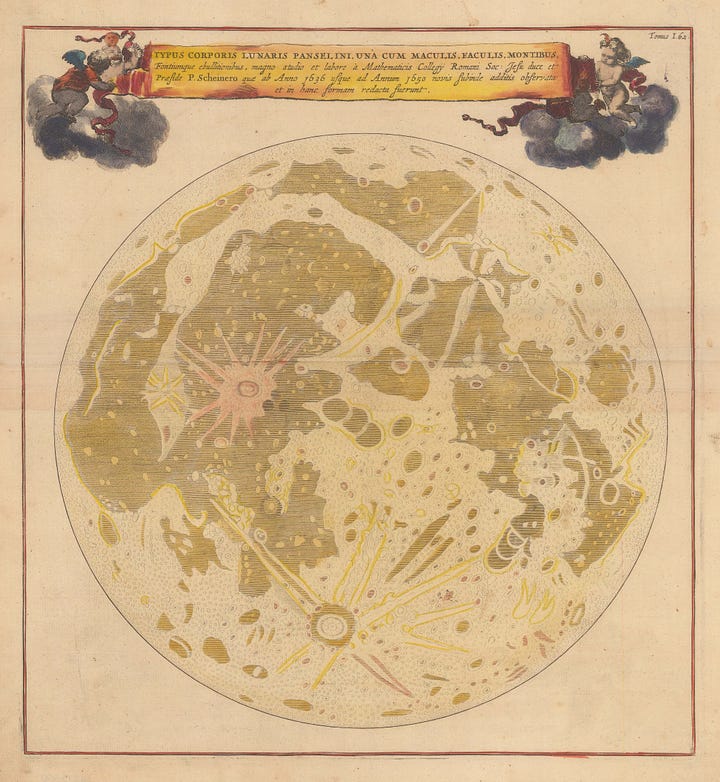
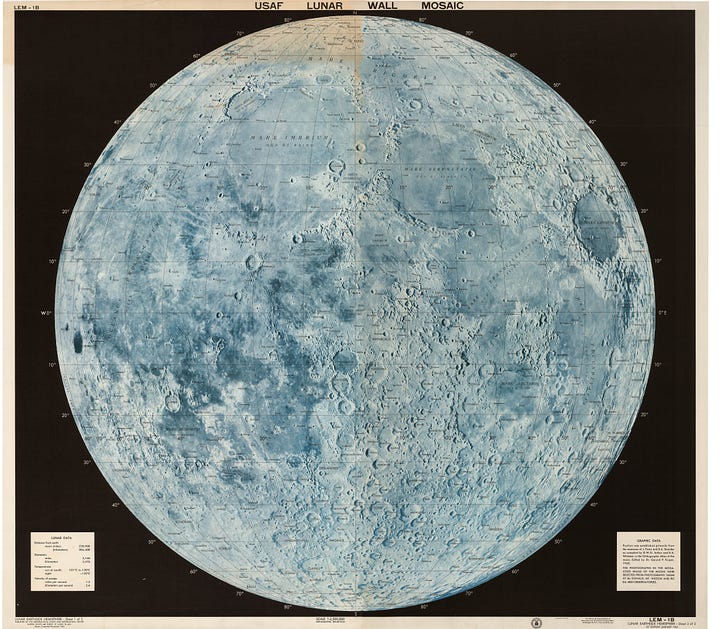
I am not sure what kind of seasons or weather I am likely to encounter up there. Nevertheless, I would spend mornings or afternoons taking long, solitary jaunts, learning to navigate the craters and the cliffs, and I would come to know the pockmarks and scars of this landscape as one learns a face. For victuals, there are little pale pink berries that grow on silver bushes, and they are very nutritive, and there are also larger, ghostly green fruits that hang from the alabaster trees and glow at night. When one gets tired of those, one can always catch a moon-fish from the stream, though I confess they are slipperier and more wily than our Earth-fish.
The far side of the moon is separated from the near side by the Opal Mountains. On the far side live, in a largish lagoon, by a large, prismatic, crashing waterfall, the mermaids of the moon, and if you are very quiet they will let you sit on a rock nearby and watch them brush their green hair and listen to their songs, sometimes sweet, sometimes too eerie for my taste. On seeing the state of my hair, they presented me with one of their combs, which they carve out of a strange, bluish coral that grows at the bottom of the lagoon.
The lagoon is surrounded by woods, and in these woods live the fairies of the moon. I have learned a few words in their language and have even been extended a rare invitation to one of their banquets, but it was a noisy affair, and it descended into revels too arcane for my present understanding of their culture. The moon-mermaids and moon-fairies keep cordial relations with each other, but there is much politicking, for the former race is quite proud, and the latter somewhat temperamental. In the Opal Mountains live the moon-gnomes, who keep to themselves and to their chief occupation: mining for gemstones, which they like to hoard—I don’t know for what, but they are rather a covetous bunch.
I would try to make friends with all these beings as best I could, but I admit that loneliness is a chief worry. If I might persuade a star to send a message for me to someone on Earth once in a while—or if someone might build a telephone line from the Earth to the moon—then I believe my happiness really would be complete.
Mood Board of the Week
(left to right, top to bottom)
Museum of the Moon, Luke Jerram, exhibited at the University of Bristol, UK: Luke Jerram is a British artist whose work often combines art and science, and Museum of the Moon is no different. For this installation, which has been on world tour since 2016, Jerram created a replica of the moon that measures 7 meters in diameter, with each centimeter representing approximately 5 kilometers of the moon’s surface, drawing on data from NASA. The installation is accompanied by a soundtrack by composer Dan Jones, and each venue that this moon is installed in is encouraged to create its own program of “events beneath the moon.” Jerram’s hope is to bring forth mythologies, interpretations, and cultural associations of the moon from all over the world, from Beijing to Bilbao, Terni to Toronto. My favorites are the installations in cathedrals—they marry science and spirituality in a way that truly inspires awe.
Very Large Telescope, European Southern Observatory, Cerro Paranal, photographed by Eric Lagadec: This photograph depicts one of the four Auxiliary Telescopes that make up the ESO’s Very Large Telescope in the Atacama Desert of Chile. I love the rosy lighting of this photo and the way the “mouth” of the telescope seems to be opening to just snap up the moon. You can read more about these telescopes here.
Illustration by Charles Dudley Tennant for The Tatler, vol. 77, #1127 (1923): Charles Dudley Tennant was born in England in 1867 and worked as an artist and landscape painter, becoming a regular illustrator for several magazines over the last decade of the 19th century and into the 20th. This illustration is so dreamy and ethereal, and I love how it almost looks like this woman (is she a fairy?) has just conjured the moon for the night with her wand. When published, the picture was accompanied by one of my favorite poems, “The Night Has a Thousand Eyes” by Francis William Bourdillon.
Moon goddess Chang’e in a landscape, Chinese School (c. 1960s): I first heard of the myth of Chang’e in a poem by Lily Zhou that I encountered one day in Poetry magazine, entitled “Moon Sonnet.” In the myth, Chang’e is a woman renowned throughout China for her beauty. She is married to the archer Hou Yi, who was rewarded by the gods with an elixir of immortality after he shot down nine of the ten suns that were scorching the earth. However, he had no wish to go on living eternally if his beloved wife could not also join him. He charged her with safekeeping of the elixir. One day, thieves entered the house and tried to steal it, and in desperation, Chang’e drank it up. She became immortal, ascended to the moon, and became the Moon Goddess.
Karlie Kloss for Armani Privé Spring 2010 Couture: When Giorgio Armani debuted this collection, obviously taking its inspiration from a lunar theme, he told the press he had been “thinking about something romantic and dreamy, far away from our everyday life. Something less harsh.”2 The moon references are beautiful—the soft, silvery colors; the elegant silhouettes, clasped together by gleaming crescents; the watery, dreamlike staging—and a bit tongue-in-cheek—Vlada Roslyakova dressed as a full moon; the updos waxed into stiff lunettes.
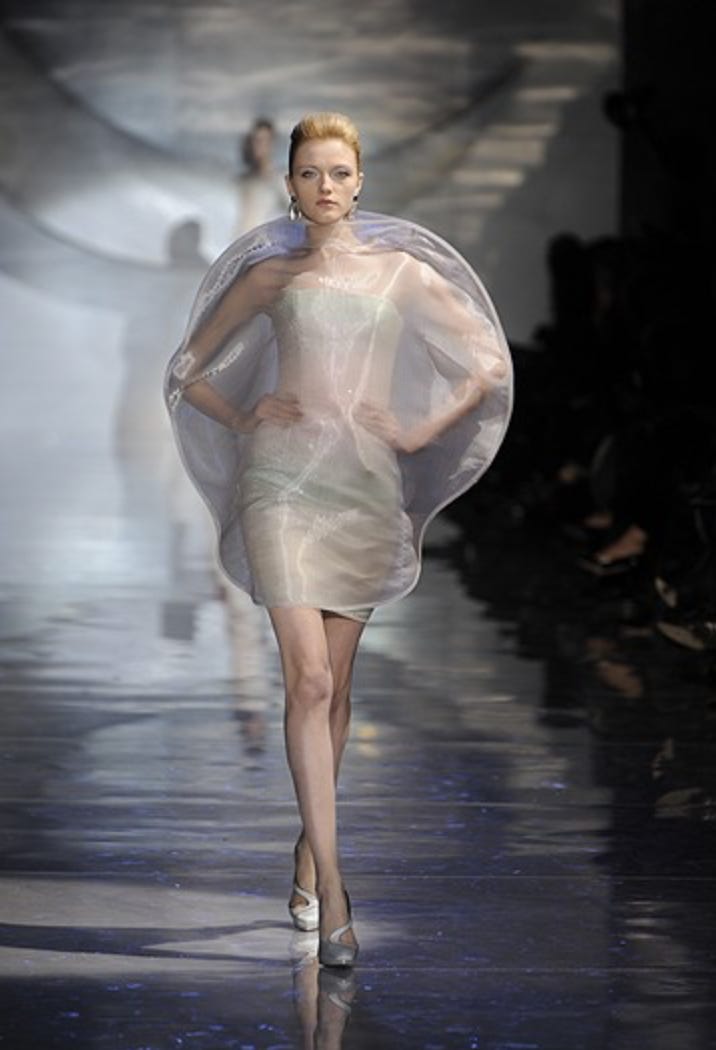
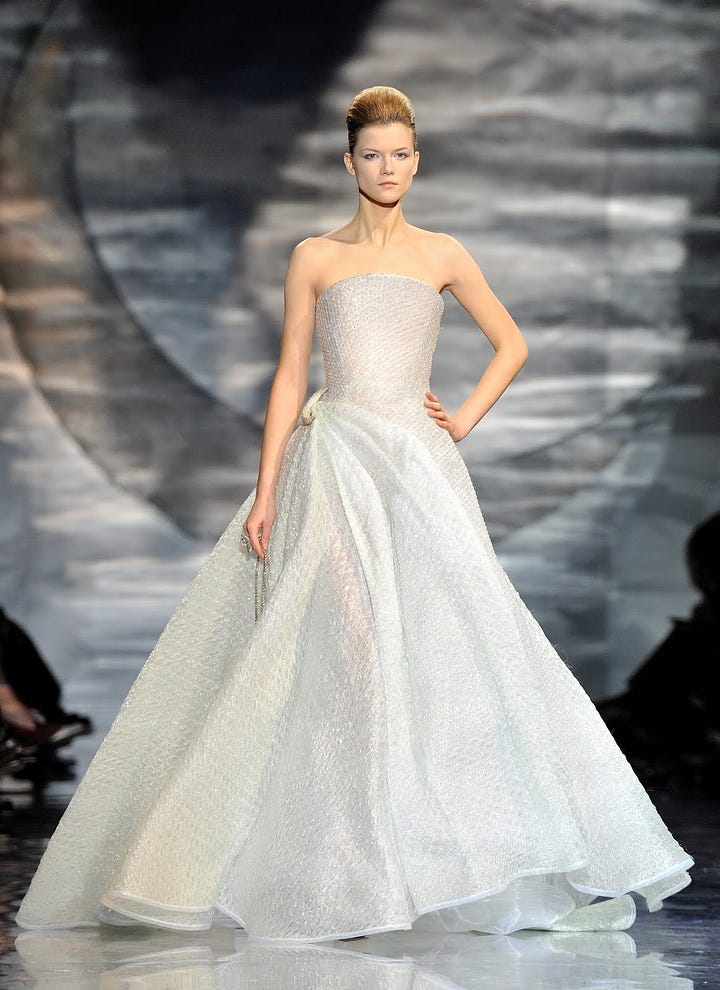
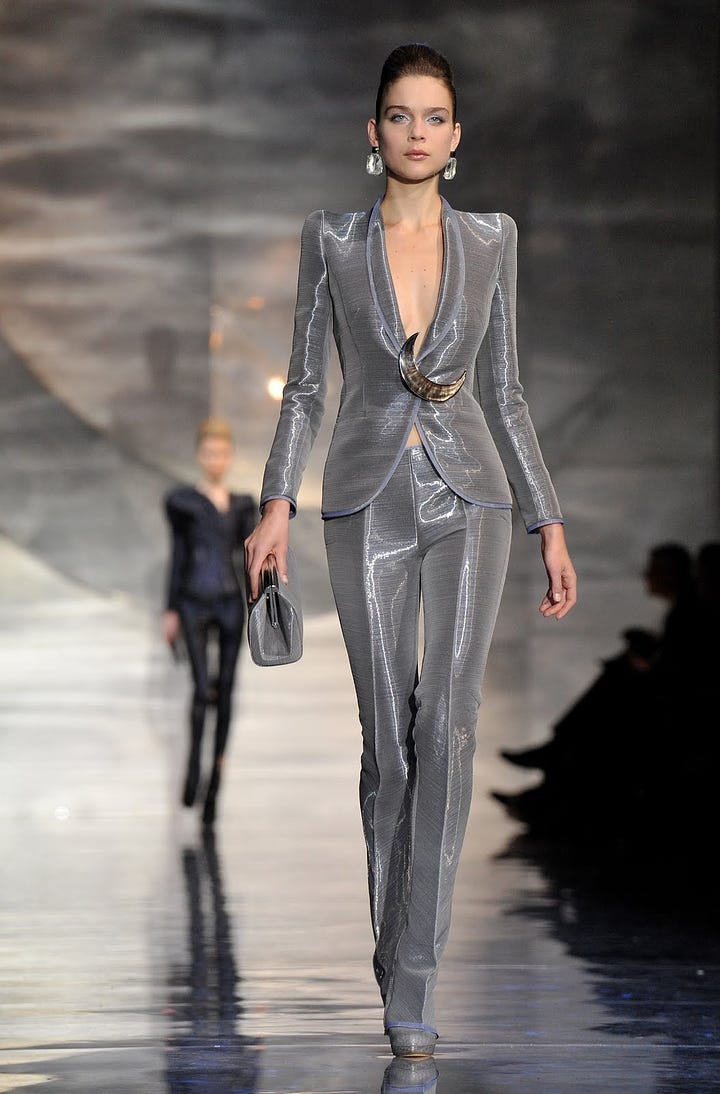
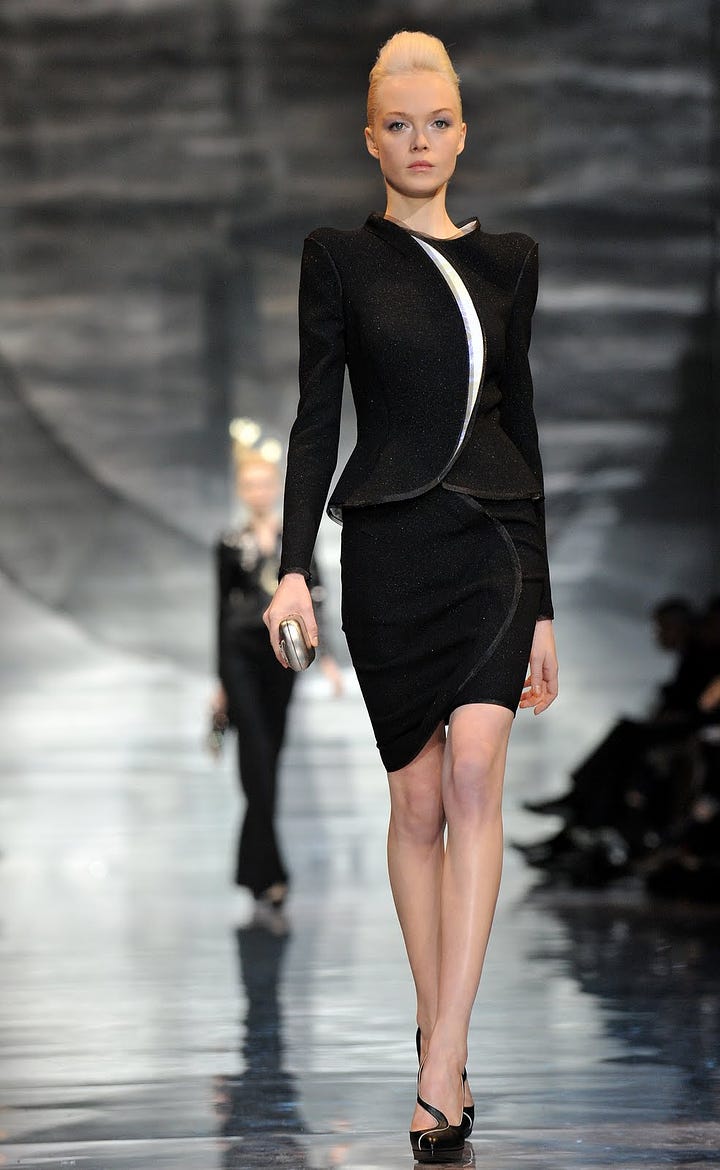
Woman in the Moon (1929): This is Fritz Lang’s last silent film, and it’s a wonderful early instance of science fiction in cinema. Lang based the film’s plot on a novel by his wife, Thea von Harbou, that had been published the year before; von Harbou also wrote the film’s script. In the movie, the entrepreneur Helius undertakes to realize the theories put forth by his scientist friend, Professor Mannfeldlt—namely, that there are vast quantities of gold on the far side of the moon. Helius assembles a rocket crew that includes himself, Mannfeldt, Mannfeldt’s pet mouse Josephine, Helius’ assistant Windegger, his other assistant Friede, who is engaged to Windegger and whom Helius secretly harbors a love for, and the financier Turner, who, unbeknownst to all, is involved with a gang of unsavory businessmen who want the gold for themselves. The moon is reached; the gold is found; and Turner’s plot is unfolded, resulting not only in the deaths of Mannfeldt and Turner but also in damage to the oxygen tanks. Due to a lack of oxygen, one of the crew must remain on the moon: straws are drawn, and Windegger must remain. Seeing his anguish, Helius drugs him so that he can go back to Earth with Friede. However, in a final twist, it turns out Friede loves Helius and has decided to stay with him. The two embrace on the moon in an ending that is at once mawkish and moving. / The effects of this movie on the future of space travel are fascinating. Many features of the rocket launch depicted became standard during the space race, including the countdown to zero and the use of water on the launch pad. Indeed, the film was actually banned in Germany from 1933-45 because its rocket was so similar to the V2 rocket the Nazis developed. A reference to the film was even painted on the nose of the first successfully launched V2.

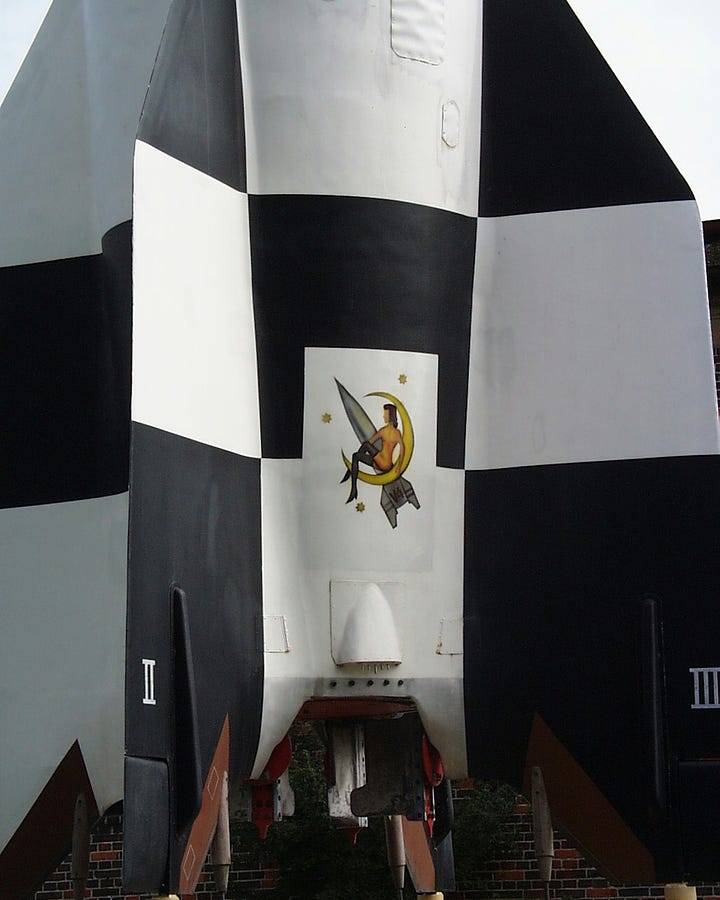
Hermann von Kaulbach, The Fairy of the Moon (c. 1891): Hermann von Kaulbach was born in Munich in 1846 and quit medical school in order to study painting, becoming known for his depictions of historical figures and of tales from German folklore. Critics of the day took issue with what they saw as his excessive attention to detail, but the way he captures children especially is really very touching. Here I love how the moon fairy sits in the crescent, a star in her diadem, her scarf trailing moonlight.3
Patrycja Wróbel, Twilight: I love the way this painting depicts the moon as being held up by a hot-air balloon, with all the little stars in the background also hovering from their own balloons. It reminds me of the e.e. cummings poem that begins “who knows if the moon’s / a balloon” and also of a Note I posted ages ago—you see, I finally did manage to write about hot-air balloons, somehow! Here’s a graphic I made on Photoshop when I was a teenager, inspired by the e.e. cummings poem—I include it here mainly because of the moon balloon, and not because of its quality:
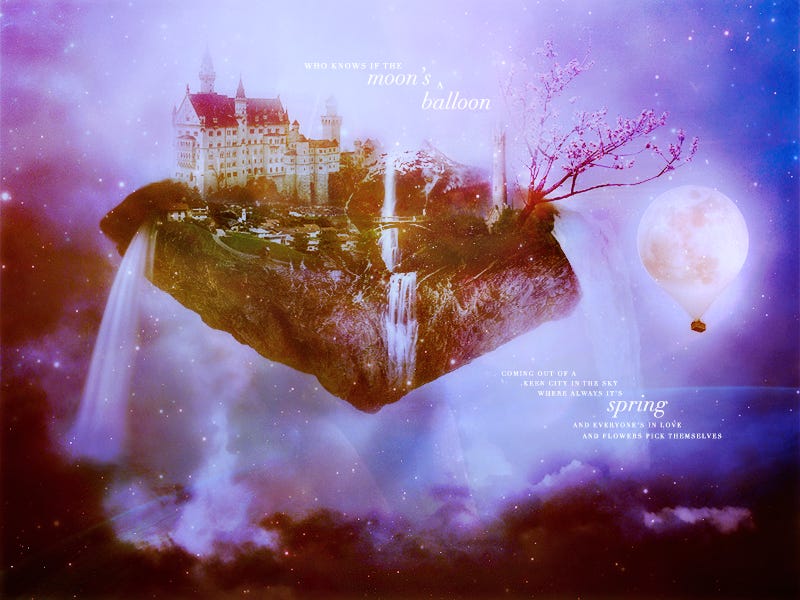
Late Victorian moonstone brooch, set in white and rose gold with diamonds and rubies: I love how this “man in the moon” depiction is carved into moonstone—how fitting! It just looks so round and serene and content.
3 Things I’m in Love With This Week
I Know Where I’m Going! (1945): You have to love a film with an exclamation mark in its title. “I Know Where I’m Going” is a traditional Scottish folk ballad about a young woman who pines to be with her lover Johnny, despite his bad reputation; it is used to great effect in I Know Where I’m Going!, a British romance film by Michael Powell and Emeric Pressburger, in which a young woman, Joan Webster, pines to be with her betrothed, the wealthy, much older businessman Sir Robert Bellinger, despite his pomposity and their incompatibility. As the song plays over the opening titles, we get a sequence of the infant, toddler, and child Joan, who at every stage of life knows exactly where she’s going.
25-year-old Joan is no different: at the beginning of the film, she brings her bank manager father—whom she touchingly addresses as “darling”—to a posh bar, where she tells him of her engagement to Bellinger. Curiously enough, she leaves Daddy darling behind in Manchester as she makes her way to the fictional Scottish Isle of Kiloran, where Bellinger is Laird and where they are to be wed. The journey is smooth enough—first by train, then by boat—until a gale sweeps up right before the last leg, leaving Joan stranded on the Isle of Mull. Just as this fierce wind overturns her carefully laid-out path, so too does charming Royal Navy officer Torquil MacNeil, who, it turns out, is the true Laird of Kiloran—Bellinger is only renting the island. Torquil introduces Joan to the simple Scotsmen and women who may be cash-poor but are immensely rich in values, character, and the connections they have to each other and their culture. Sometimes the best paths are the ones that find you. As Scottish poet Robert Burns said, “The best-laid schemes o’ mice an’ men / Gang aft agley.”4
“Islands of the Mind” by Heidi Leitzke: Leitzke makes beautiful thread paintings on linen, layering over the embroidery with delicate washes of paint to achieve an effect that is at once dreamlike and tactile, ethereal and solid. “My work is rooted in observation of nature, while exploring the realms of my imagination… nature serves as a symbolic expression of my human experience,” she says. She first turned to needle and thread after the birth of her son, as hand-held embroidery is very portable, easy to pick up, put down, and return to at a moment’s notice. “The complicated surface texture created by thread woven into linen has a seductive quality, which appeals to a human’s desire to touch.”5
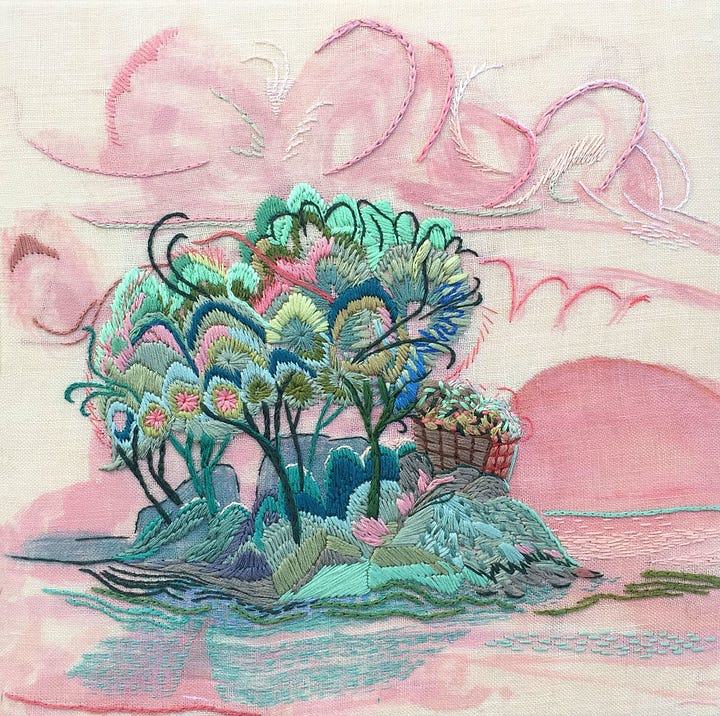
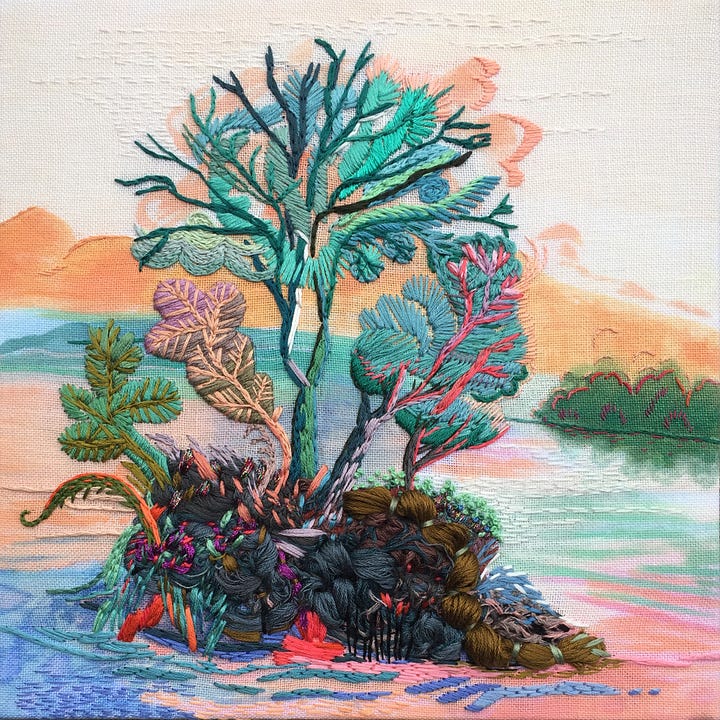
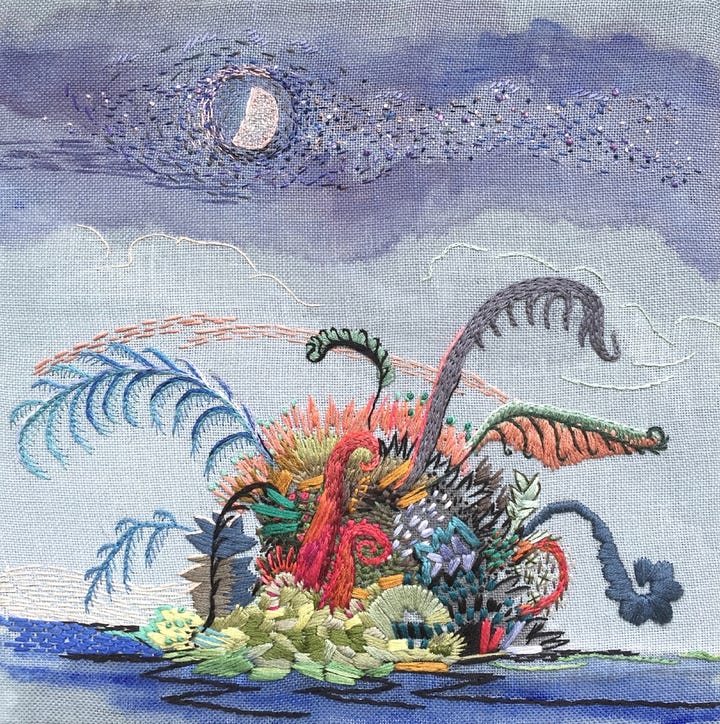
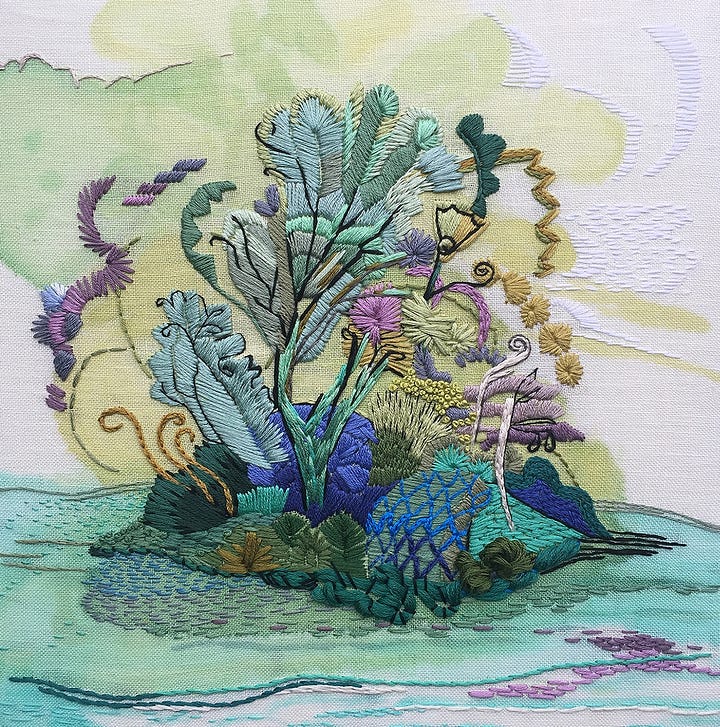
The paintings of Kazu Saito: Kazu Saito is a Japanese artist who practices Nihonga, a term coined in the Meiji period for Japanese-style painting to differentiate it from Yōga, Western-style painting. I love the delicacy, tranquility, and gentle beauty of his works. They seem to express a sort of fragility and effervescence about life, and yet something that stirs one, like a soft wind gently moving a few branches. Speaking on the inspiration he gets from nature, he has said, “Rather than drawing it as it is, I often try to portray the ‘feeling’ of the moment when I interact with nature.”6
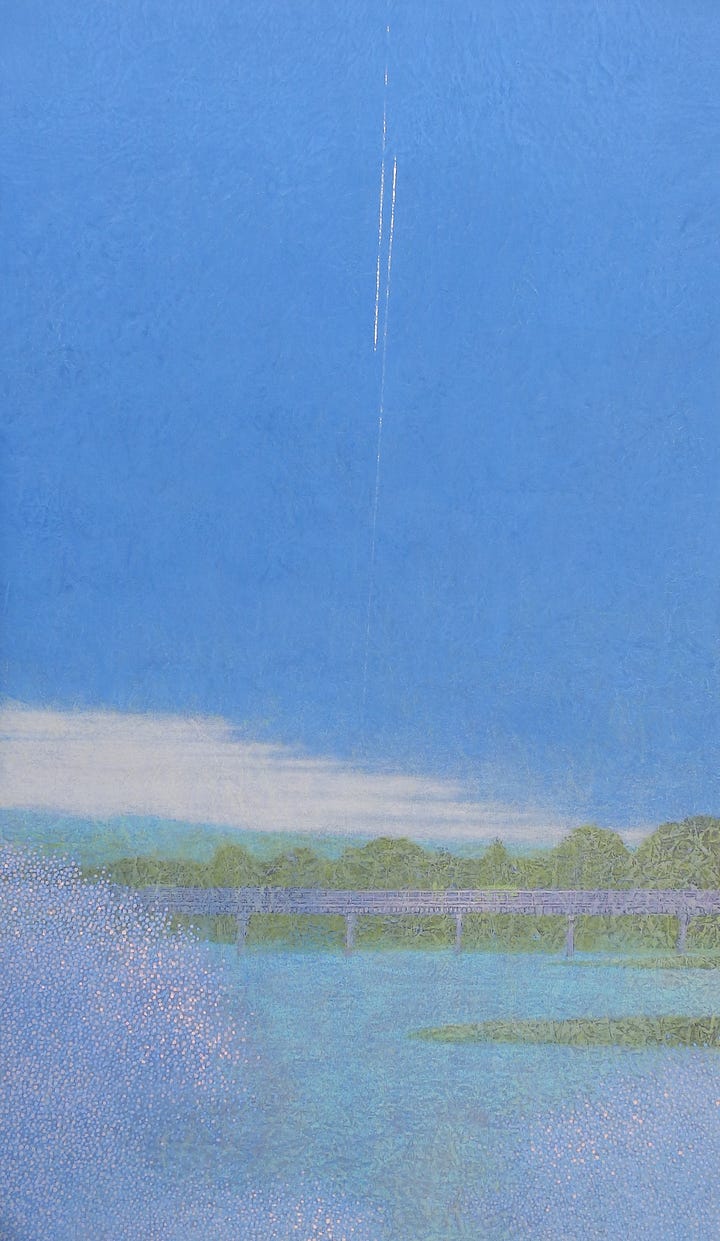
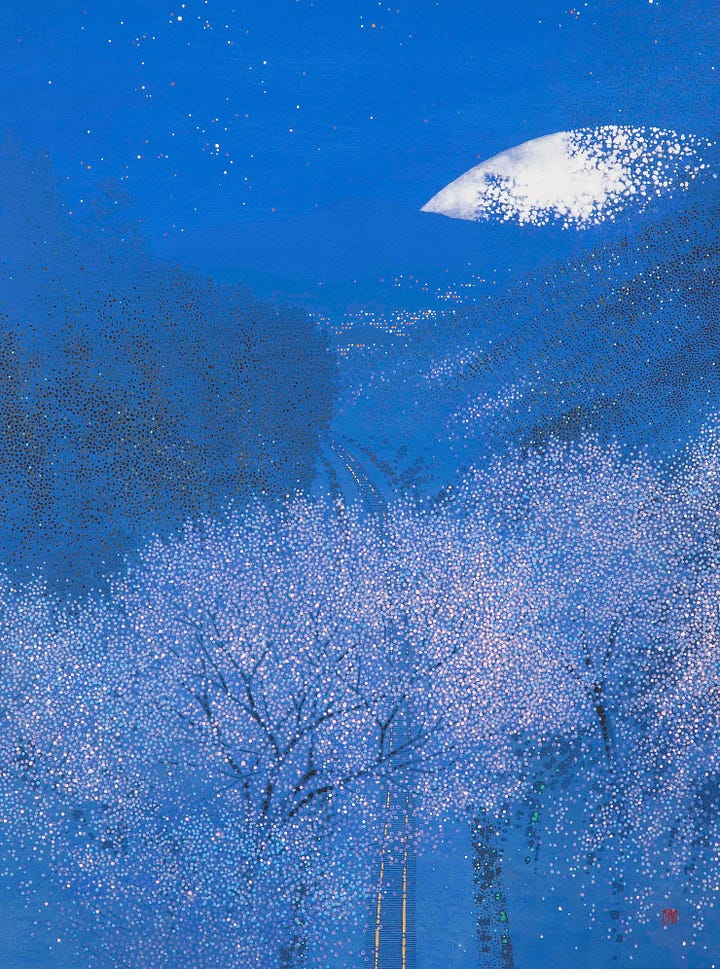
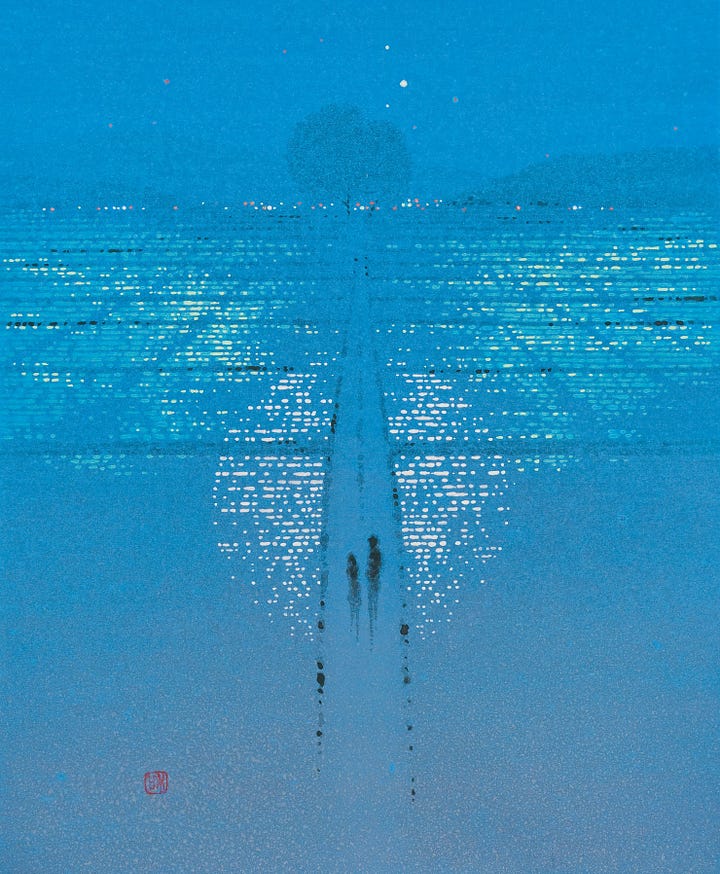

Words of Wisdom
“Any destiny at all, however long and complicated, in reality consists of a single moment: the moment in which a man once and for all knows who he is.”
— Jorge Luis Borges, “Biography of Tadeo Isidoro Cruz (1829-74),” translated by Anthony Kerrigan
Poetry Corner
This week we have two bits of poetry, dear readers, since I couldn’t pick between them! The first is a little poem by Emily Dickinson, the second is the first few lines from Shakespeare’s A Midsummer Night’s Dream, a play which always makes me think of moonlight in a fairy garden.
The Moon is distant from the Sea— And yet, with Amber Hands— She leads Him—docile as a Boy— Along appointed Sands— He never misses a Degree— Obedient to Her eye— He comes just so far—toward the Town— Just so far—goes away— Oh, Signor, Thine, the Amber Hand— And mine—the distant Sea— Obedient to the least command Thine eye impose on me—
—Emily Dickinson
I find the gender reversal in this poem very interesting. At first the moon is personified as female, almost maternal, and the sea is male, a “docile” and “obedient” boy who goes where his mother leads him. In the last stanza, however, the “Amber Hand” of the moon comes to represent the speaker’s “Signor,” who imposes commands upon the presumably female speaker, now identified with the sea. The flexibility of these roles suggests that power relations are dynamic, not rigid and hierarchical, for Dickinson; the speaker seems to be a follower who is at once helpless and willing.
THESEUS Now, fair Hippolyta, our nuptial hour Draws on apace. Four happy days bring in Another moon. But, O, methinks how slow This old moon wanes! She lingers my desires Like to a stepdame or a dowager Long withering out a young man’s revenue. HIPPOLYTA Four days will quickly steep themselves in night; Four nights will quickly dream away the time; And then the moon, like to a silver bow New-bent in heaven, shall behold the night Of our solemnities.
—William Shakespeare, A Midsummer Night’s Dream
The play opens up with Theseus, the Duke of Athens, complaining to his betrothed, Hippolyta, the Queen of the Amazons, that there are still four days left until their wedding—until the new moon. Theseus feels like a “young man” waiting around for a dowager to die so he can finally inherit. In contrast, Hippolyta focus on the new moon rather than the old moon, comparing it to a “silver bow,” a simile that is particularly apt because the Amazons are warrior women and huntresses. For her, the four days and nights will go quickly—I love the image of day “steep[ing]” itself in night and night “dream[ing] away the time.” The dreamiest of Shakespeare’s plays!
Beauty Tip
Reciprocate a kind gesture you have received recently.
Lingering Question
What is one thing others deem “unrealistic” that you have a secret hope of accomplishing?
Etc, Etc.
SOME LUNE-Y TUNES
—
Dear Readers, I hope you enjoyed this one! I’m sorry I haven’t been posting as consistently—still trying to get back into the groove of things little by little. I hope you are all having a lovely September so far. Do let me know what you thought in the comments, leave a like if you enjoyed, and subscribe to Soul-Making for more!
As some of you may have noticed from my Notes, I have been very happily rereading Jane Eyre. The passage that continues from the quoted section was too long for me to include entirely in the body of the post, but I wanted to leave it here, since I love it so much:
“She will have nothing to eat—you will starve her,” observed Adèle.
“I shall gather manna for her morning and night; the plains and hill-sides in the moon are bleached with manna, Adèle.”
“She will want to warm herself; what will she do for a fire?”
“Fire rises out of the lunar mountains; when she is cold, I’ll carry her up to a peak and lay her down on the edge of a crater.”
“Oh, qu’elle y sera mal—peu comfortable! [Oh, she'll be uncomfortable there!] And her clothes, they will wear out; how can she get new ones?”
Mr. Rochester professed to be puzzled. “Hem!” said he. “What would you do Adèle? Cudgel your brains for an experiment. How would a white or a pink cloud answer for a gown, do you think? And one could cut a pretty enough scarf out of a rainbow.”
“She is far better as she is,” concluded Adèle, after musing some time; “besides, she would get tried of living with only you in the moon. If I were mademoiselle, I would never consent to go with you.”
“She has consented—she has pledged her word.”
“But you can’t get her there; there is no road to the moon—it is all air, and neither you nor she can fly.”
“Adèle, look at that field.” We were now outside Thornfield gates, and bowling lightly along the smooth road to Millcote, where the dust was well laid by the thunder-storm, and where the low ledges and lofty timber trees on each side glistened green, and rain-refreshed.
“In that field, Adèle, I was walking late one evening about a fortnight since—the evening of the day you helped me to make hay in the orchard meadows; and as I was tired with raking swaths, I sat down to rest me on a stile; and there I took out a little book and a pencil, and began to write about a misfortune that befell me long ago, and a wish I had for happy days to come; I was writing away very fast, though daylight was fading from the leaf, when something came up the path and stopped two yards off me. I looked at it. It was a little thing with a veil of gossamer on its head. I beckoned to it to come near me; it stood soon at my knee. I never spoke to it, and it never spoke to me, in words; but I read its eyes, and it read mine; and our speechless colloquy was to this effect:
“It was a fairy, and come from Elf-land, it said; and its errand was to make me happy; I must go with it out of the common world to a lonely place—such as the moon, for instance—and it nodded its head towards her horn, rising over Hay-hill; it told me of the alabaster cave and silver vale where we might live. I said I should like to go; but reminded it, as you did me, that I had no wings to fly.
“‘Oh,’ returned the fairy, ‘that does not signify! Here is a talisman will remove all difficulties;’ and she held out a pretty gold ring. ‘Put it,’ she said, ‘on the fourth finger of my left hand, and I am yours, and you are mine; and we shall leave earth, and make our own heaven yonder.’ She nodded again at the moon. The ring, Adèle, is in my breeches pocket under the disguise of a sovereign; but I mean soon to change it to a ring again.”
“But what has mademoiselle to do with it? I don’t care for the fairy; you said it was mademoiselle you would take to the moon—!”
“Mademoiselle is a fairy,” he said, whispering mysteriously.
Somehow this picture reminded me of a picture of a very different sort, one of the burlesque dancer Dita von Teese in her younger years.
“Gang aft agley.” = Go often awry. From “To a Mouse.”





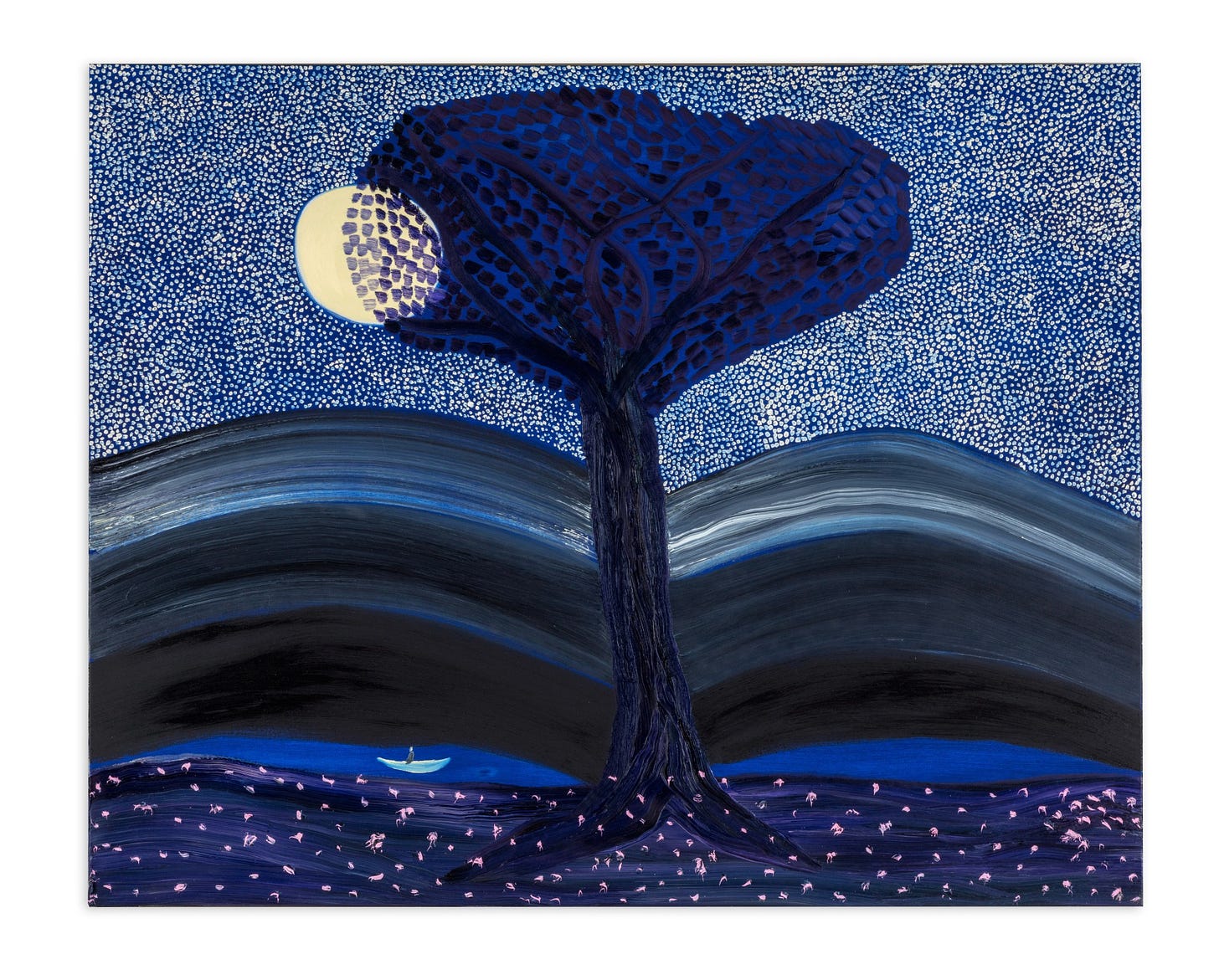
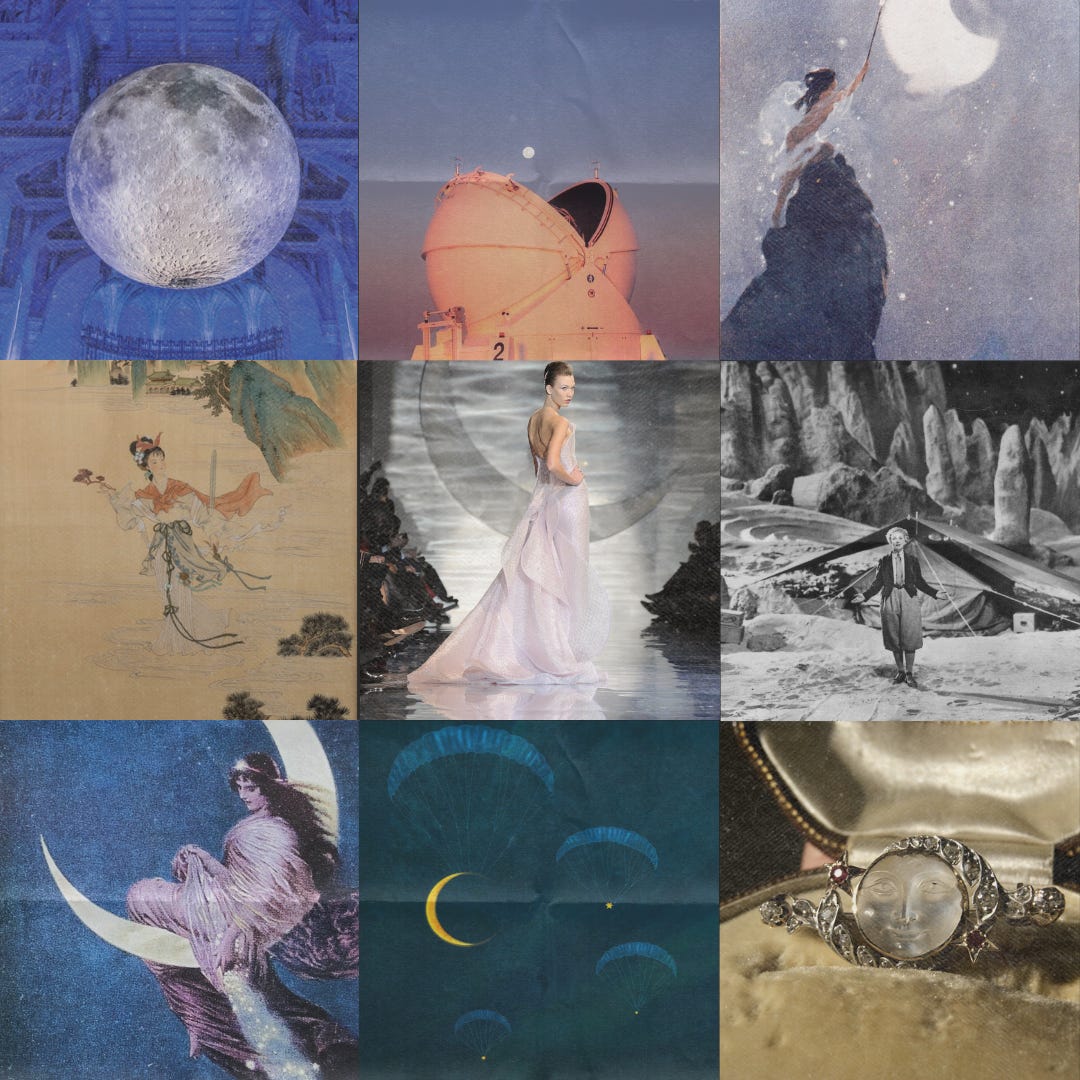
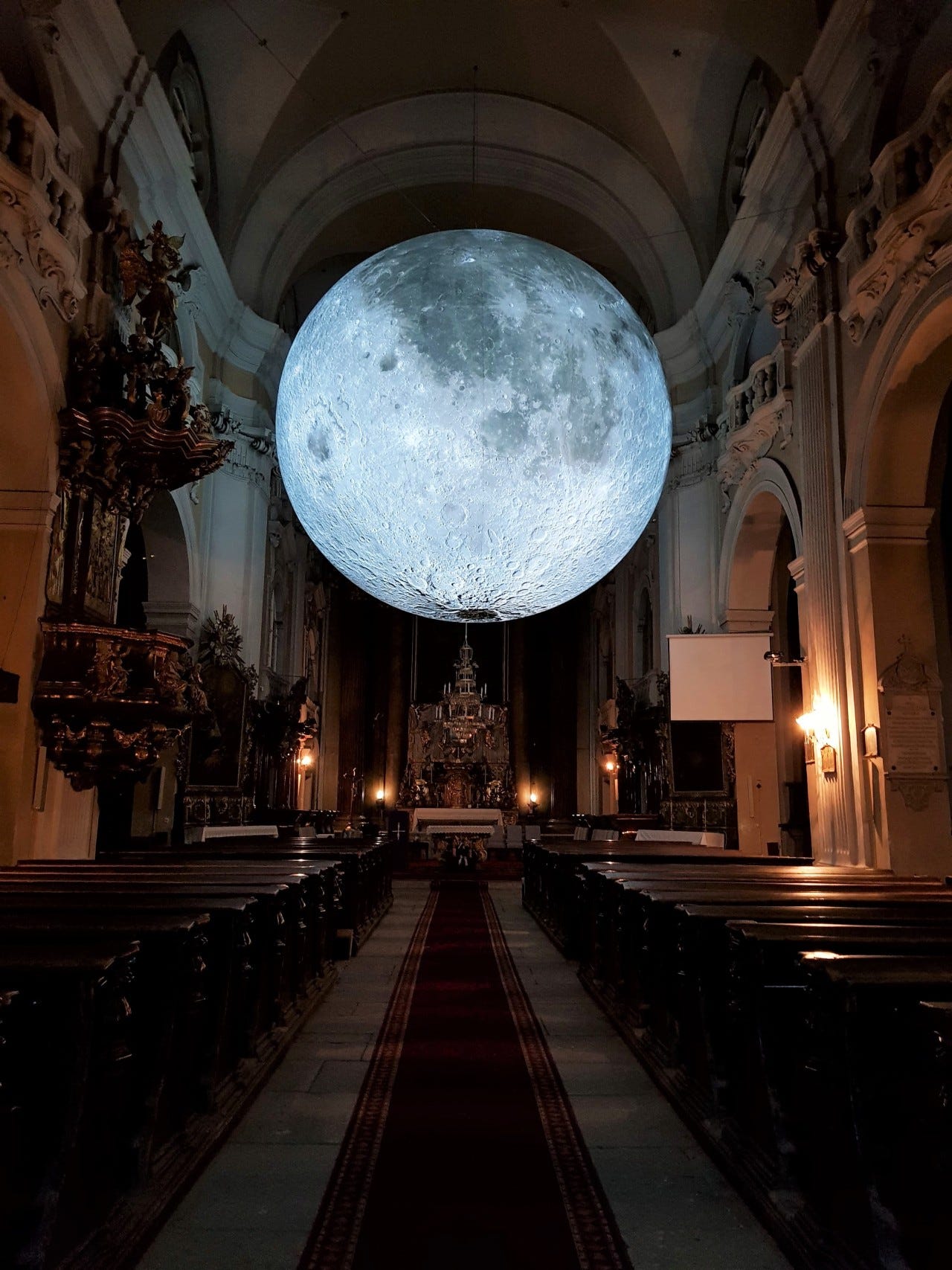

Happy I came across yor Friday Frivolities. This one enchants me. Thank you for sharing your gift of invoking beautiful images in my mind.
Ramya, as always, great piece. Incidentally, the full moon is right around the corner for this month and I will remember your words on living on the moon!